Brushed: A finish produced on knit or woven fabrics in a process in which brushes or other abrading or brushing elements are used to raise a nap.
Calendered: A finish produced by passing fabric under pressure between cylinders. The number of cylinders varies, and the greater the heat and pressure, the greater the luster. The process produces a flat, glossy and smooth surface on the fabric.
Filling: The yarn that runs from selvage to selvage at right angles to the warp. Each yarn of the filling is called a pick (most common), shoot, shot, or shute.
Fulled: A finish produced on woolens or worsted in which the newly woven or knitted cloth is felted or compressed. The material is subject to moisture, heat, friction and pressure, causing it to shrink considerably in both directions, becoming compact and solid. In heavily fulled fabrics, both the weave and yarn are obscured entirely, giving the appearance of felt.
Napped: A finished produced on certain woolens, cottons, spun silks and spun rayons, consisting of raising a nap on the fabric. A napper machine has rapidly revolving cylinders covered with fine wire brushes which lift loosely twisted yarns from the fabric to form the nap.
Mercerized: Cotton yarn or fabric which has been treated by swelling in strong alkali. The material in the form of warp, skeins or piece goods is immersed in sodium hydroxide (caustic soda) solution. Later this is neutralized in acid. The process causes a permanent swelling of the fiber, increasing its luster, strength, and affinity for dyes.
Slub: A thick, unevenly twisted place in yarn. May be deliberately inserted in a fancy yarn or a flaw in yarn that is supposed to be of uniform diameter.
Wale: One of a series of ribs, cords, or raised portions usually in the fabric length.
Warp: A yarn that runs lengthwise in a woven fabric, parallel to the selvages. Warp ends interlace with the filling yarns (picks) in different patterns to form different weaves.
Next: My "first impression" method for determining a fabric.
Popular Posts
-
Every week, the Vintage Fashion Guild has a fashion parade, where trade members show off their finds suited to the week's theme. I'm...
-
I think I may have seen one or two Avengers episodes as a child, and I remember how funny, bright and eccentric everything seemed. Fast for...
-
According to the Feeding America site, the contribution I was able to make yesterday will translate into 1172 meals for hungry Americans.
-
Kelly Bundy with short hair/bob, red-red cropped top and 1990s jeans ;) 90s floral dress with split Black crop top and red-red skirt 90s cro...
-
BUSINESS Although high fashion magazines didn't dwell on business fashion (some would call it anti-fashion), they couldn't complete...
-
With so much focus on the sad event that took place 100 years ago, I thought I'd mention a few of the other events of 1912—specifically ...
-
I consider runway fashion to be in the (no pun...) running for future vintage, and here are some of my favorites from fall 2011 runways. It ...
-
One most excellent (and, I might add, hopeful) definition of elegance comes from Geneviève Antoine Dariaux at the start of her book Elegance...
-
If you know me at all, you know I am very concerned for endangered species, probably none more than the manatee. Manatees are gentle aquatic...
A few fabric definitions
Basic fabric weaves
I remember wondering not so long ago what a person meant by, say, "silk satin jacquard," or "wool crepe." Trying to figure out these definitions I started breaking down the categories into which each fabric falls. Leaving aside the fiber content (wool, poly, cotton, etc.) for the moment, I used an idea I got from bird identification books, of looking for the most noticeable feature and working out from there.
I came up with a list of "first impression" groupings of fabrics, and I'll get to that soon. First, these are the basic weaves, showing illustrations from Fabrics and How to Know Them by Grace Goldena Denny, 1928 edition. Keep in mind this is what the fabric looks like through a magnifying glass!:
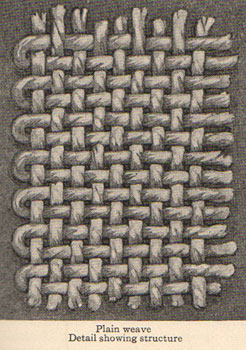
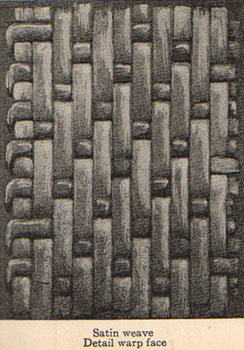
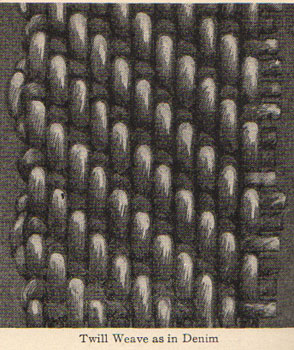
And a knit is not a weave at all. This is its basic structure:
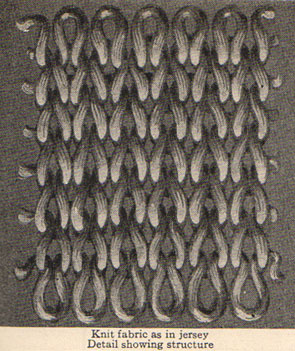
These are the basic weaves as more graphically illustrated in the Fairchild's Dictionary of Textiles:
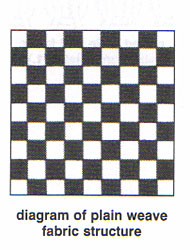
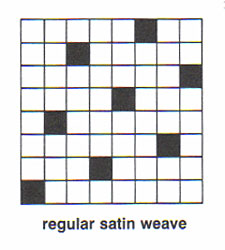
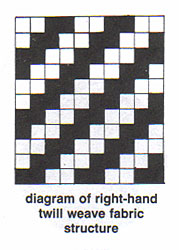
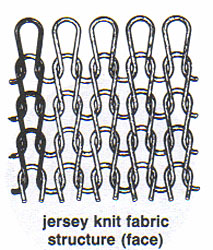
Next time: Some fabric definitions
How I am getting to know fabrics, part 2
Unfortunately, tagging around with an expert is unlikely to get you terribly far these days, unless you are lucky enough to be near a very fine fabric store, or if you are very lucky, a museum with a textile collection. The usual chain fabric stores are pretty slim on the variety of fabrics that were used for vintage clothing, or for better modern clothing.
A terrific resource then is a book of fabric swatches, and there is a series of three by Julie Parker: All About Silk: A Fabric Dictionary & Swatchbook (Fabric Reference Series, Volume 1), All About Cotton: A Fabric Dictionary & Swatchbook (Volume 2) and All About Wool: A Fabric Dictionary and Swatchbook (Volume 3). All, Rain City Publishing, Seattle, Washington, in multiple printings.
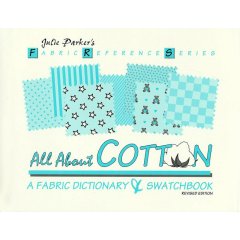

These three books have swatches of the most commonly found fabrics in pure silk, pure wool and pure cotton. There is also a lot of other information, written and printed in an easily digested, enjoyable way. Included is a rating of each fabric for sewing, fit, suggested styles, cost, wearability, suggested care and where to find. These books are pretty costly, about $25 to $35 each, either new or used, yet they are priceless resources for getting to know fabrics.
The only drawback that I can find is that these only take a very curious soul so far; if you want to know even more about fabrics, you will need to widen your net. What, for instance, of all the wonderful blends? What of synthetics and rayon?
I started my own swatch library, index cards on which I sewed swatches of fabrics when I was absolutely sure I had an example. The collection is pretty large by now. A great find was a 1950 swatch book of Fabrics For Fall (McGreevey, Werring & Howell Co.), 70 pages of good-sized pieces of fabric in a fine array of prints, weaves and fibers, all named. If you can find this sort of book at an antique shop, yard sale, or equivalent, I highly recommend you grab it!
Next time: Fabric basics.









